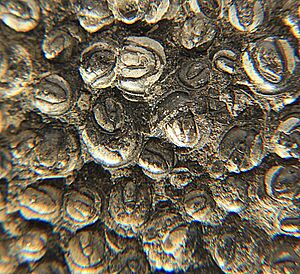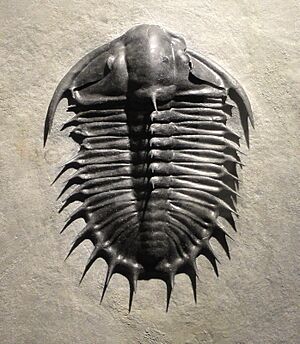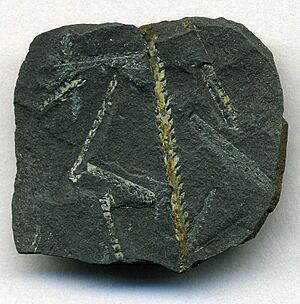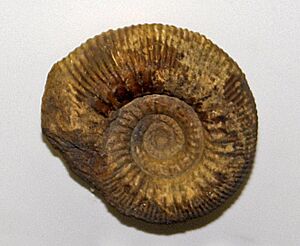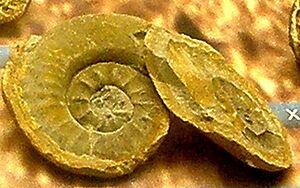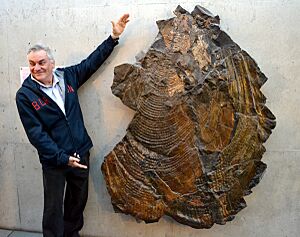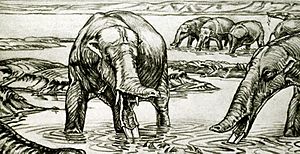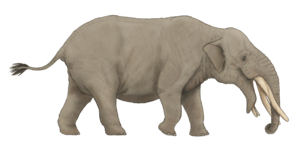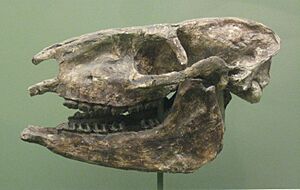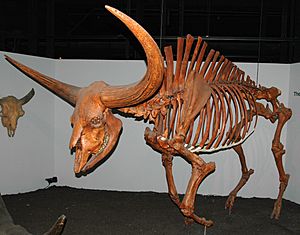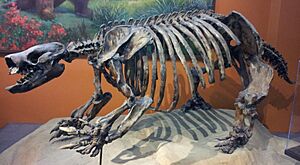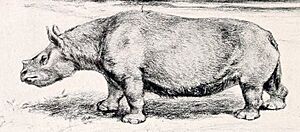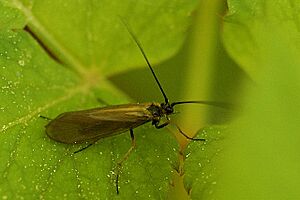List of the prehistoric life of Idaho facts for kids
The prehistoric life of Idaho tells us about the amazing ancient plants and animals whose fossils have been found in the US state of Idaho. These fossils help scientists understand what Idaho was like millions of years ago, long before humans lived there. From ancient sea creatures to giant mammals, Idaho has a rich history of life that has changed over vast periods of time.
Contents
Paleozoic Era: The Age of Ancient Life
The Paleozoic Era lasted from about 541 to 252 million years ago. During this time, Idaho was often covered by warm, shallow seas. This means many of the fossils found from this era are marine (ocean) creatures.
Sea Creatures of Ancient Idaho
Many types of ancient sea animals lived in Idaho during the Paleozoic Era.
- Trilobites: These were ancient arthropods, like distant relatives of modern crabs or insects. They had hard shells and lived on the seafloor.
- Agnostus was a small, blind trilobite that lived in the Cambrian period.
- Olenoides was another type of trilobite, known for its spiny body.
- Graptolites: These were tiny colonial animals that often floated in the ancient oceans. Their fossils look like small saw blades or branches.
- Climacograptus is a well-known type of graptolite found in Idaho.
- Ancient Sharks: One of the most unique creatures from Idaho's Paleozoic past is Helicoprion. This ancient shark relative lived during the Permian period. It had a bizarre spiral-shaped jaw filled with teeth, like a circular saw.
 Life restoration of the Permian Chimaera relative Helicoprion
Life restoration of the Permian Chimaera relative Helicoprion - Corals: Like modern corals, ancient corals built reefs in the warm seas. Syringopora was a type of tabulate coral, forming tube-like colonies.
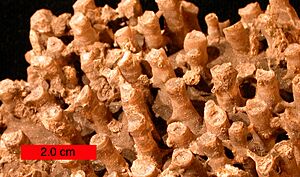 Fossil of the Devonian tabulate coral Syringopora
Fossil of the Devonian tabulate coral Syringopora - Brachiopods: These are shelled marine animals that look a bit like clams but are different inside. Composita and Spirifer are common brachiopods found in Idaho.
- Nautiloids: These were ancient relatives of squids and octopuses, living inside coiled or straight shells. Pleuronautilus was one such nautiloid.
Mesozoic Era: The Age of Dinosaurs
The Mesozoic Era, from about 252 to 66 million years ago, is often called the "Age of Dinosaurs." Idaho's landscape changed, with more land environments appearing, though parts were still covered by seas.
Dinosaurs and Marine Reptiles
While Idaho isn't famous for many dinosaur finds, some important fossils have been discovered.
- Ichthyosaurs: These were marine reptiles that looked like dolphins or fish. They swam in the ancient seas that covered parts of Idaho. Cymbospondylus was a large ichthyosaur that lived during the Triassic period.
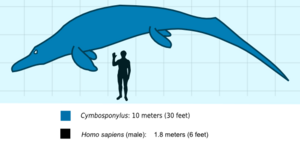 Diagram illustrating the Middle-Late Triassic ichthyosaur Cymbospondylus with an anachronistic human to scale.
Diagram illustrating the Middle-Late Triassic ichthyosaur Cymbospondylus with an anachronistic human to scale. - Dinosaurs: One notable dinosaur fossil found in Idaho is Tenontosaurus. This was a plant-eating dinosaur, related to the Iguanodon, that lived during the Early Cretaceous period. It was known for its strong tail.
 Life restoration of the Early Cretaceous Iguanodon relative Tenontosaurus
Life restoration of the Early Cretaceous Iguanodon relative Tenontosaurus - Ammonoids: These were shelled cephalopods, similar to nautiloids, but with more complex shell patterns. They are very common fossils in Mesozoic rocks. Arcestes, Normannites, and Xenodiscus are examples found in Idaho.
- Giant Clams: Inoceramus was a type of giant marine bivalve (like a clam) that lived from the Early Jurassic to the Late Cretaceous. Some Inoceramus shells could grow to be very large!
Cenozoic Era: The Age of Mammals
The Cenozoic Era began about 66 million years ago and continues to the present day. After the dinosaurs died out, mammals became the dominant large animals. Idaho's landscape became more like it is today, with forests, grasslands, and mountains.
Mammals and Birds of Cenozoic Idaho
Idaho has many fossils from the Cenozoic Era, showing a variety of mammals and birds.
- Ancient Elephants: Several types of elephant relatives roamed Idaho.
- Amebelodon was a "shovel-tusked" elephant relative from the Miocene epoch. Its lower tusks were flattened and used for scooping up plants.
- Mammut americanum, or the American mastodon, was a large, hairy elephant relative with straight tusks.
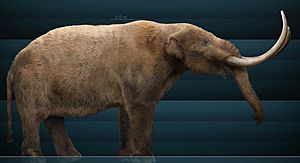 Restoration of a Mammut americanum, or American mastodon
Restoration of a Mammut americanum, or American mastodon - Mammuthus columbi, the Columbian mammoth, was a giant woolly mammoth that lived during the Ice Age.
- Rhynchotherium was another elephant relative with long, downward-curving tusks.
- Ancient Horses: Idaho is famous for its fossil horses, especially from the Hagerman Fossil Beds National Monument.
- Equus simplicidens, also known as the Hagerman horse, is one of the oldest known true horses. It lived during the Pliocene and Pleistocene epochs and looked a lot like a modern zebra.
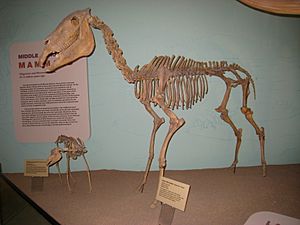 Fossilized skeleton of the Pliocene-Pleistocene horse Equus simplicidens, also known as the Hagerman horse or American zebra
Fossilized skeleton of the Pliocene-Pleistocene horse Equus simplicidens, also known as the Hagerman horse or American zebra - Miohippus was an earlier, three-toed horse from the Eocene-Oligocene epochs.
- Equus simplicidens, also known as the Hagerman horse, is one of the oldest known true horses. It lived during the Pliocene and Pleistocene epochs and looked a lot like a modern zebra.
- Giant Bison: Bison latifrons was a huge bison with enormous horns that lived during the Pleistocene Ice Age.
- Saber-Tooth Cats: Smilodon fatalis was a famous saber-tooth cat, known for its long, sharp canine teeth. It was a powerful predator during the Pleistocene.
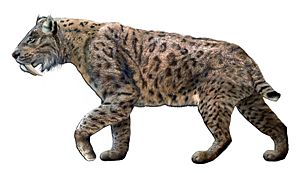 Life restoration of the Pleistocene-Holocene saber-tooth cat Smilodon
Life restoration of the Pleistocene-Holocene saber-tooth cat Smilodon - Other Large Mammals:
- Camelops was a large, extinct camel that lived in North America.
- Megalonyx and Paramylodon were types of giant ground sloths, slow-moving plant-eaters.
- Teleoceras was a rhinoceros that looked a bit like a modern hippo, spending time in water.
- Homotherium, or the scimitar cat, was another type of saber-toothed cat with shorter, curved fangs.
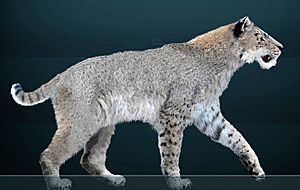 Restoration of Pliocene-Pleistocene Homotherium, or scimitar cat
Restoration of Pliocene-Pleistocene Homotherium, or scimitar cat
- Ancient Plants: Idaho's Cenozoic fossils also include many plants, showing ancient forests with trees like Metasequoia (dawn redwood), Ginkgo, and various types of pines and oaks.
Birds and Insects
Fossils of birds and insects also tell us about Idaho's past.
- Ciconia maltha, also known as the asphalt stork, was a large stork that lived during the Pliocene and Pleistocene.
- Insects like the caddisfly Limnephilus have also been found, showing that these small creatures have been part of Idaho's ecosystems for a long time.


